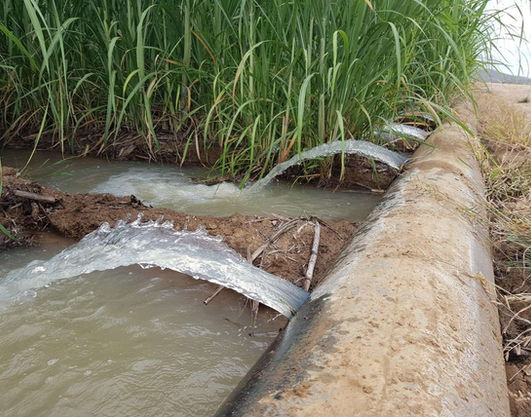
Why does irrigation need to be managed?
Typically, about 20% of applied furrow irrigation water runs off the paddock. If irrigation is not carefully managed, this excess water use can be problematic to the farm and the environment.
Field measurements show water runoff continues from furrow-irrigated paddocks long after the pumps have been shut off. This prolonged watering can:
Heighten the risk of applied fertiliser and pesticides to runoff paddocks and reach local waterways.
Cause water to seep down and be lost as deep drainage, causing rising groundwater levels.
Result in paddock waterlogging that can impact sugarcane growth.
Monitoring results show that growers who adopt improved irrigation practices can halve water loss – lowering the risk of losses via surface runoff and deep drainage while saving money on water charges and pumping costs.
Understanding a crop’s water needs allows for tailored irrigation strategies that can greatly reduce water usage.
How can irrigation be managed?
Extension providers establish water quality monitoring programs to help growers understand how much irrigation, along with pesticides and fertilisers, is being lost off their farms.
Given the unique conditions of each farm, irrigation practices must be customised to suit individual needs. The team evaluate data to recommend farm irrigation interventions that consider soil type, block layout, water inflow rates, and soil moisture levels.
Growers can fine-tune their irrigation methods to reduce losses by increasing water inflow and using mid-stream shutoffs. They also use modern technologies like automated pumps, valves, sensors, and advanced scheduling programs - conserving both water and energy.
Irrigation technologies allow for efficient management and allow growers to remotely manage their irrigation systems from their devices. This eliminates the need to manually adjust or turn off their pumps.
Recycling pits
Some growers use recycle pits to manage and contain smaller irrigation runoff events from parts of their farm. But while they are effective for this purpose, they are not suitable for handling large runoff events for the entire farm.
Recycle pits need to be carefully managed to prevent overflow into downstream waterways and wetlands, which can become significant pathways in transporting pollutants.
What are the benefits of improved irrigation practices?
Monitoring results show that improved irrigation practices can halve water loss. With less water running off the paddock, improved irrigation practices can bring benefits to the farming enterprise and the environment by:
Saving energy costs by reducing pump run times and the number of irrigations required over the growing season.
Savings in labour and improvements in workplace health and safety, including reduced after-hours labour.
Reduced fluctuations in channel levels.
Less volume of runoff in tailwater drains.
Contributes to addressing rising groundwater table concerns.
Foster healthier soil conditions (less waterlogging).
Reduce nutrient and pesticide runoff reaching waterways.
By implementing efficient irrigation methods, growers can foster healthier soil conditions, lower operational costs, reduce runoff and deep drainage, and contribute to the long-term preservation of agricultural and ecological resources.


Key points
Irrigation can be integral for many farming systems. It provides growers with a consistent and reliable water supply.
Despite its advantages, excessive irrigation can result in paddock runoff, rising groundwater levels, water logging (impacts cane growth), and operational costs.
Monitoring results show that water use in some areas can be halved by adopting improved irrigation practices, significantly benefiting the farm and the environment.








